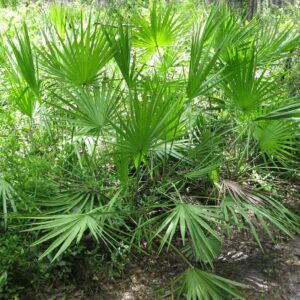The botanical name for Saw Palmetto is Serenoa repens
Family – Palmae
Common Names
Other names include dwarf palm, fan palm and cabbage palm. “Saw” refers to its sharp-edged palmate leaves. “Palmetto” is descriptive of the plant’s overall appearance as a member of the palm family. The botanical name “Serenoa” is after a famous botanist Dr. Sereno Watson of Harvard University.
Description of Saw Palmetto
Saw Palmetto is endemic to the Florida peninsula and the southern coastal plains of the United States. That means, the only place this plant grows is in the southern US from southeastern Louisiana to South Carolina, including all of Florida.
With a maximum height of between 7 to 10 feet, Saw Palmetto grows mainly as a small creeping shrub or shrubby tree. Its colonies grow in thick, dense, almost impenetrable thickets intermixed with sparse southern pine forests.

The leaves are large and fan-shaped or “palmate”. Each “palm” contains between 18 to 24 lance-shaped leaflets. The individual leaflets have sharp serrated edges resembling (and acting like) saws. Overall, the appearance of the shrubs range in color from blue green to yellow green to almost silvery white.
Fragrant flowers appear in large, ivory-white clusters in May and June each year. The resulting fruits or berries ripen in “drupes” or drooping clusters from September through December. Drupes of olive sized purple/black berries can be 18 to 24 inches long and weigh as much as 8 lbs. The oily Saw Palmetto fruits have a distinctive odor, like overripe cheese. The flesh of the fruit is juicy inside containing a single, hard, oily seed.
Part Used
The fruit or berries. Saw Palmetto berries are (or were) a staple food for native peoples. Though, by all accounts they where an acquired taste. They are, however, nutritious and life sustaining. Very good for you.
Harvesting and Ecological Status
Saw Palmetto is a huge industry in the herbal supplement world. Yet, is not threatened or endangered. But is considered an abundant natural resource. Because plants grow in thick colonies, they are difficult get at and harvester. Therefore harvesters tend to stay to the outside edges of thickets. Harvesting only about 6% of what grows in the wild each year. Saw Palmetto is sometimes grown on farms. Though plantation farming is really an effort to make harvesting easier and not a reflection of its ecological status.
Want to know more about growing and harvesting? Click here for a great read about the process of harvesting Saw Palmetto berries by Steven Foster and the American Botanical Council.
Ripe berries are put in direct sun or under heating machines until they reach the consistency of prunes. Then moved to a slower more consistent heat until completely dried. When purchasing dried Saw Palmetto berries, they should be black/purple in color, with a hard-shriveled appearance. Medicinally active dried berries will have their characteristic odor. Dried fruit stays active for about 1 year.
Products made with fresh berries, and those made with berries at the prune-like stage are considered superior. As are berries grown closer to the shoreline.
Medicinal Properties of Saw Palmetto
Saw Palmetto is considered the gold standard for male reproductive issues. Yet, like most plants marketed by “big business,” its usefulness has a much broader scope.
The bulk of Saw Palmetto’s healing properties come from its nutritive value. As an amphoteric herb, it normalizes the function of the reproductive system for both men and women. But also has affinities for the respiratory, digestive, immune and the genitourinary system.
Medicinal properties include uses as an adaptogen (helping mind and body deal with stress) and as an antiandrogenic (reduces or harmonizes testosterone levels in the blood). It is a hormonal regulator, anti-inflammatory, diuretic, expectorant, immune amphoteric (normalizes immune function), urinary antiseptic, demulcent, alterative (cleansing the blood) and anti-spasmodic.
Click here for a definition of herbal actions and medicinal properties. See attached
The taste is sweet and acrid. The energy is warm and moist.
Preparations of Saw Palmetto
Saw Palmetto is available in a variety of herbal preparations. The berries have complex chemistry. This makes different preparations better suited for different conditions. For example, water-based preparations such as teas, decoctions, syrups and others with less than 20% alcohol are ideal for working with immune, nutritional and lung issues. Alcohol extracts of 70% or more are best for reproductive and urinary problems. The suggested dosage for the tincture is 1-2 ml (30 to 60 drops) twice per day.
Standardized gel caps are a favorite of the Naturopathic doctors because each gel cap contains the same amount of active ingredient. Plus, they are in a capsule, so patient compliance is greater. The suggested dose is 160 milligram dose per day.
Capsules of the powdered herb are the least effective. Dried berries, especially when powdered, lose their medicinal value quite quickly. Smelling the capsules is the best way to tell if they are medicinally active. If they smell like old cheese, they’re still good. But unfortunately, we never know how long a product has been on the shelf or how long it took to get there. Plus, I don’t think the store would appreciate us opening each jar to smell the product before buying them. So, unless you’re purchasing from a retailer you trust, it might be best to avoid encapsulated Saw Palmetto altogether.
Medicinal Use of Saw Palmetto
As previously mentioned, the uses of Saw Palmetto are abundant. This plant helps normalize functioning of the reproductive and hormonal systems for both men and women. Commonly used to treat chronic urinary, respiratory, immune and digestive disorders. When there is a deficiency, its use vitalizes the systems and the body. When the problem is excess and inflammation, using this herb creates a calming and cooling effect. A “smart” herb, always seeking to support the system while helping the body return to normal. That said, Saw Palmetto is most effective when their is a deficiency or when functioning is less than optimal.
Men’s Reproductive Uses
For men, Saw Palmetto berries help modulate testosterone (and other hormones) with an affinity for the genital-urinary system. It has the ability to decrease inflammatory responses related to excess “free” testosterone, making it perfectly suited for dealing with BPH (benign prostatic hyperplasia). Likewise, Saw Palmetto often used in formula to treat urethritis and nonbacterial prostatitis. As well as to decrease nighttime urination, frequent urination and to tone or stabilize urine flow.
Medicinal Use of Saw Palmetto
As previously mentioned, the uses of Saw Palmetto are abundant. This plant helps normalize functioning of the reproductive and hormonal systems for both men and women. Commonly used to treat chronic urinary, respiratory, immune and digestive disorders. When there is a deficiency, its use vitalizes the systems and the body. When the problem is excess and inflammation, using this herb creates a calming and cooling effect. A “smart” herb, always seeking to support the system while helping the body return to normal. That said, Saw Palmetto is most effective when their is a deficiency or when functioning is less than optimal.
Contrary to some belief, Saw Palmetto does not decrease the size of the prostate or increase the size of the testis. In fact, it has very little effect on a healthy reproductive system. However, because it helps balance reproductive hormones, the use of the berries can be useful for andropause, or male menopause. Saw Palmetto indicated when impotence or infertility is the result of deficiency or high stress. Further, this herb may be helpful when the testis lack tone or have atrophied or in cases of testicle or epididymis inflammation. (The epididymis is a coiled tube at the back of the testicle that stores and carries sperm.)
Women’s Reproductive Uses
Again, the strength of Saw Palmetto comes from the ability to normalize hormonal and reproductive function. For women it is useful when working with issues where testosterone is out of balance. This makes it useful for conditions like PCOS (polycystic ovarian disease) and hirsutism. Saw Palmetto may be useful for problems related to an excess of estrogen during the second half of the menstrual cycle. For example, Ovarian cysts, heavy menstrual bleeding, infrequent or absent ovulation, and some PMS issues sometimes respond well to Saw Palmetto. Especially if Vitex doesn’t help.
Saw Palmetto is a great herb to add into the formula to help restore vaginal and uterine tone. For women, this herb seems to be most effective when the woman is in the middle of a hormonal change or imbalance. The kind of change common during menopause, puberty and pregnancy. It is also used to address breast complaints. Particularly when lesions are present or when breasts have atrophied. Also, Saw Palmetto is used to treat infertility and loss of libido in women when it is caused by exhaustion or excessive childbearing.
Both men and women use Saw Palmetto to relieve pelvic congestion (not bloating). It is indicated when there is tenderness or pain in the abdomen. This herb may be helpful for treating patterned baldness in both men and women. Finally, its use may be helpful during puberty to address late maturation and the deep cystic acne that plagues some teenagers.
Saw Palmettos use for the urinary system
Saw Palmetto acts as a general tonic to the bladder and the entire urinary system. Additionally, it helps tone the urinary muscles and sphincter. As a result, it supports the flow of urine and is useful for incontinence due to lack of tone and in the elderly. And to treat an irritable bladder.
Respiratory uses
Saw Palmetto often helps resolve chronic respiratory mucus including postnasal drip, an irritating cough and laryngitis. Helping resolve chronic or long-lasting irritating mucus. The kind of mucus resistant to other herbal expectorants and medical treatment. Saw Palmetto used for treating a chronic bronchial cough, whooping cough, asthma, sinus congestion, postnasal drip and even snoring.
In a state of deficiency there may be an overall thinness, poor nutrition and pale skin. Moreover, the eyes may be sunken or dull, and infections may be frequent or recurring. Sometimes the depletion comes after a bout of sickness.
The digestive System and using Saw Palmetto as a nutritive tonic
According to King’s Dispensary, written by eclectic physicians Harvey Wickes Felter, M.D., and John Uri Lloyd, Phr. M., Ph. D, 1898 – Saw Palmetto is a “Superior nutritive tonic, stimulating the appetite, improving digestion, and the assimilation of nutrients.” As a reflection of nature, this observation mirrors what can be observed in the wild. Many animals that depend Saw Palmetto berries for nourishment grow thin during the months before the fruit ripens. Then as the fruit ripens, they become, thick and robust. Their energy and full health restored. The nourishment of the harvest then carries them until the next year.
As humans, this herb builds up flesh and makes the user more robust. Making it useful for underdeveloped individuals, and for those who could use a nerve tonic. In cases of failure to thrive, emaciation of the sick and the elderly, Saw Palmetto can be mixed with Marshmallow and/or Ashwagandha. For the weak and elderly no longer able to assimilate nutrients, try adding Ginseng and Gotu kola or Ashwagandha. Used by people who have frequent or chronic viral or bacterial infections that have nutritional or immune deficiencies.
Pretty cool huh.
Recipes:
One possible formula for BPH
David Winston’s formula for Benign Prostatic Hyperplasia (BPH) Mix equal parts of individually formulated herbal tinctures of Aromatic Collinsonia (Collinsonia canadensis) Nettle Root (Urtica Dioica) Saw palmetto (Serenoa Repens) White Sage (Salvia apiana) The suggested dose is 80 drops, 4 millilitres 4 times per day
One possible formula for Saw Palmetto Tea
Nutritional Tea to Harmonize Immune system Saw Palmetto (Serenoa repens) 2 parts American Ginseng (Panax quinquefolius) 1 part Astragalus root (Astragalus membranaceas) 1 part Schisandra Berry (Schisandra chinensis) 1 part Fresh Ginger (Zingiber officinale) 1 part Orange Peel (Citrus X sinensis) 1 part Combine the Saw Palmetto, American Ginseng, Astragalus Root and Schisandra Berry. Grind the herbs
in a coffee grinder. Add 2 teaspoons of ground herb per 16 ounces of water. Slowly simmer until
liquid is reduced to ½ its volume (20-30 minutes). Remove from heat and add ½ teaspoon fresh grated ginger and a ¼ teaspoon of orange peel. Cover
and let steep for 10 – 20 minutes. Strain. Drink 2 or 3 cups per day throughout the day.
Contra-Indications
The medical community has some concern that Saw Palmetto could mask rising PSA levels, hiding a growing cancer concern. Do no use with advanced BPH or severe urinary retention. In those cases, rule out prostate cancer first.
Not recommended in pregnancy or when breast-feeding due to its potential hormonal activity.
Other contra-indications include low grade diarrhea, chronic flatulence and abdominal bloating.
Possible Side Effects
Uncomfortable reactions usually appear when the dosage is too large. However, side effects are always possible with any herb.
Possible side effects include mild nausea, gastric upset, headache and diarrhea. If these symptoms present themselves, stop taking it and talk to your healthcare provider.
References
The Toil of the Harvest: Saw Palmetto
Winston, David, Herbalist AGH; Saw Palmetto for Men and Women, Story Books; Pownal, Vermont. 1999
Other Posts You Might Like
Disclaimer
The statements and ideas presented here are not intended to diagnose, treat, cure, or prevent any disease or condition. They have not been evaluated by the FDA. All ideas presented are for the sole purpose of education. To help you take control of your own health. If you have a health concern or condition, consult a physician. We suggest that you always consult a medical doctor before modifying your diet, using any new product, drug, supplement, or doing any new exercises.
These statements and products have not been evaluated by the FDA. They are not intended to diagnose, treat, cure, or prevent any disease or condition. If you have a health concern or condition, consult a physician. Always consult a medical doctor before modifying your diet, using any new product, drug, supplement, or doing any new exercises.
Herbs taken for health purposes should be treated with the same care as medicine. Herbal remedies are no substitute for a healthy diet and lifestyle. If you are serious about good health, you’ll want to combine diet, exercise, herbals, a good relationship with your doctor and a generally healthy lifestyle. No one of these will do it alone.
This information is designed to be used as part of a complete health plan. No products are intended to replace your doctor’s care, or to supersede any of his/her advice or prescriptions.





I have been meaning to post about something like this on one of my blogs and this has given me an idea. Thanks.
What is your blog address?
Hello, I was wandering around online and I saw your site from another site. I read a few of your posts and thought they are well written. Thanks, Ill visit your page again soon.
http://www.socjologia.xmc.pl
Thank you, glad you like them and they are helpful. Did you sign up the the newsletter?
Please tell me that youre heading to keep this up! Its so beneficial and so important. I cant wait to read more from you. I just feel like you know so a lot and know how to make people listen to what you have to say. This blog is just also cool to be missed. Fantastic stuff, actually. Please, PLEASE keep it up!
Thank you, glad you like it.
You made an amazing post. Put up more content soon! I will bookmark your blog. 🙂
Thanks for the great info! I would never have found this on my own!
It’s a shame you don’t have a donate button! I’d certainly donate
to this fantastic blog! I suppose for now
i’ll settle for book-marking and adding your RSS feed to my Google account.
I look forward to new updates and will share this site with my
Facebook group. Chat soon!
Glad you like the blog. I do have a donate button it is on the Ask Annie page. here is the link https://wondermentgardens.com/ask-annie-blog/
Thanks again
Annie
Thanks for the information appreciated been reading for awhile, and just wanted to let you know I continue to enjoy your writing.
I am impressed, I have to say. Very seldom do I see a blog that is both educative and entertaining, and let me tell you, youve hit the nail on the head. Your idea is important; the matter is something that not a lot of people are talking intelligently about. Im very happy that I stumbled across this in my search for something relating to this.
with the perfect subject. Thanks for a great valuable project. Great work! Keep up the ultra do the webjob!